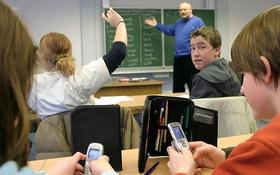Top Rankings
St. Louis Park Public School District ranks among the top 20% of public school district in Minnesota for:
Category
Attribute
Diversity
Most diverse schools (Top 1%)
Community Size
Largest student body (number of students) (Top 1%)
For the 2025 school year, there are 9 public elementary schools serving 2,910 students in St. Louis Park Public School District. This district's average elementary testing ranking is 5/10, which is in the bottom 50% of public elementary schools in Minnesota.
Public Elementary Schools in St. Louis Park Public School District have an average math proficiency score of 44% (versus the Minnesota public elementary school average of 47%), and reading proficiency score of 48% (versus the 51% statewide average).
Minority enrollment is 46% of the student body (majority Black), which is more than the Minnesota public elementary school average of 40% (majority Black and Hispanic).
Overview
This School District
This State (MN)
# Schools
13 Schools
1,655 Schools
# Students
4,347 Students
571,925 Students
# Teachers
263 Teachers
40,363 Teachers
Student : Teacher Ratio
17:1
17:1
District Rank
St. Louis Park Public School District, which is ranked within the top 50% of all 522 school districts in Minnesota (based off of combined math and reading proficiency testing data) for the 2021-2022 school year.
The school district's graduation rate of 87% has decreased from 90% over five school years.
Overall District Rank
#250 out of 527 school districts
(Top 50%)
(Top 50%)

Math Test Scores (% Proficient)
43%
45%
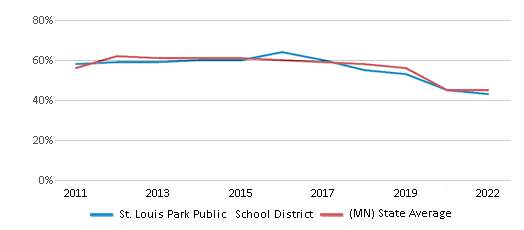
Reading/Language Arts Test Scores (% Proficient)
48%
51%
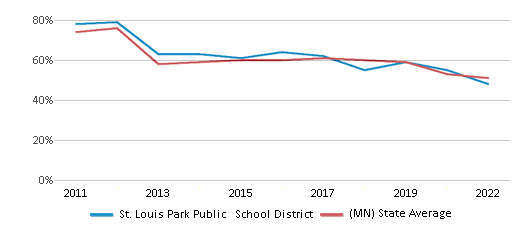
Science Test Scores (% Proficient)
44%
41%
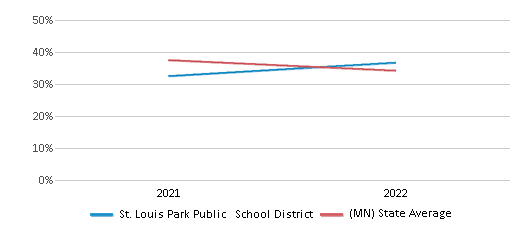
Graduation Rate
87%
84%
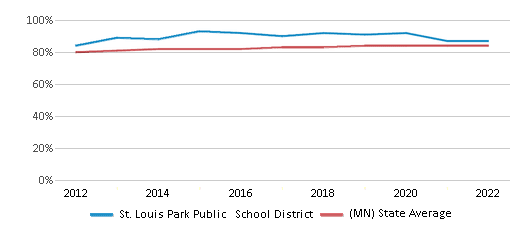
Students by Ethnicity:
Diversity Score
0.66
0.61
# American Indian Students
26 Students
10,480 Students
% American Indian Students
n/a
2%
# Asian Students
124 Students
42,165 Students
% Asian Students
3%
7%
# Hispanic Students
571 Students
65,127 Students
% Hispanic Students
13%
12%
# Black Students
852 Students
70,794 Students
% Black Students
20%
12%
# White Students
2,296 Students
344,281 Students
% White Students
53%
60%
# Hawaiian Students
8 Students
676 Students
% Hawaiian Students
n/a
n/a
# Two or more races Students
470 Students
38,402 Students
% of Two or more races Students
11%
7%
Students by Grade:
# Students in PK Grade:
83
10,698
# Students in K Grade:
323
57,031
# Students in 1st Grade:
282
61,859
# Students in 2nd Grade:
345
63,560
# Students in 3rd Grade:
283
61,751
# Students in 4th Grade:
339
63,575
# Students in 5th Grade:
317
63,290
# Students in 6th Grade:
310
63,180
# Students in 7th Grade:
315
53,666
# Students in 8th Grade:
313
53,924
# Students in 9th Grade:
326
4,107
# Students in 10th Grade:
354
4,634
# Students in 11th Grade:
375
4,740
# Students in 12th Grade:
382
5,910
# Ungraded Students:
-
-
District Revenue and Spending
The revenue/student of $21,121 is higher than the state median of $17,854. The school district revenue/student has grown by 5% over four school years.
The school district's spending/student of $28,160 is higher than the state median of $18,580. The school district spending/student has grown by 5% over four school years.
Total Revenue
$92 MM
$15,547 MM
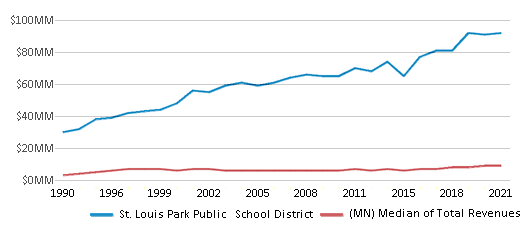
Spending
$122 MM
$16,179 MM
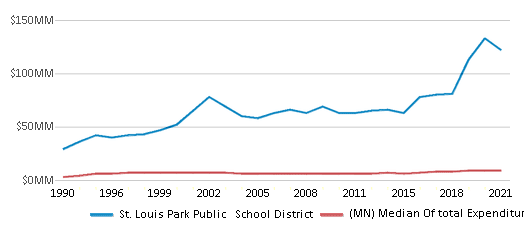
Revenue / Student
$21,121
$17,854
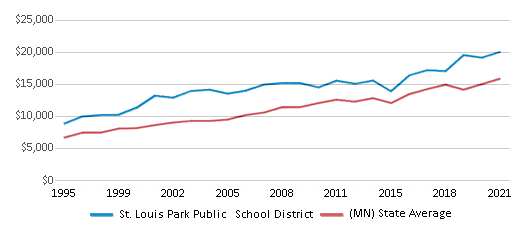
Spending / Student
$28,160
$18,580
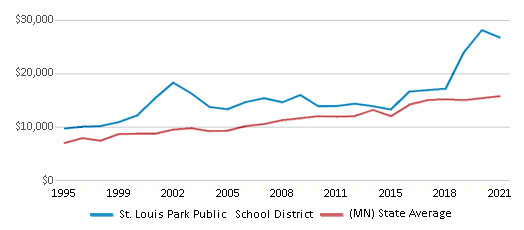
Best St. Louis Park Public School District Public Elementary Schools (2025)
School
(Math and Reading Proficiency)
(Math and Reading Proficiency)
Location
Grades
Students
Rank: #11.
Park Spanish Immersion Elementary School
(Math: 70% | Reading: 72%)
Rank:
Rank:
10/
Top 10%10
9400 Cedar Lake Rd
Minneapolis, MN 55426
(952) 928-6555
Minneapolis, MN 55426
(952) 928-6555
Grades: K-5
| 526 students
Rank: #22.
Susan Lindgren Elementary School
(Math: 53% | Reading: 56%)
Rank:
Rank:
8/
Top 30%10
4801 W 41st St
Minneapolis, MN 55416
(952) 928-6700
Minneapolis, MN 55416
(952) 928-6700
Grades: K-5
| 415 students
Rank: #33.
Aquila Elementary School
(Math: 55% | Reading: 48%)
Rank:
Rank:
6/
Top 50%10
8500 W 31st St
Minneapolis, MN 55426
(952) 928-6500
Minneapolis, MN 55426
(952) 928-6500
Grades: K-5
| 499 students
Rank: #44.
Peter Hobart Elementary School
(Math: 42% | Reading: 47%)
Rank:
Rank:
5/
Bottom 50%10
6500 W 26th St
Minneapolis, MN 55426
(952) 928-6600
Minneapolis, MN 55426
(952) 928-6600
Grades: K-5
| 449 students
Rank: #55.
St. Louis Park Middle School
(Math: 31% | Reading: 40%)
Rank:
Rank:
3/
Bottom 50%10
2025 Texas Ave S
Minneapolis, MN 55426
(952) 928-6300
Minneapolis, MN 55426
(952) 928-6300
Grades: 6-8
| 938 students
Rank: n/an/a
Melrose
Alternative School
3525 Monterey Dr
Minneapolis, MN 55416
(952) 993-6200
Minneapolis, MN 55416
(952) 993-6200
Grades: 1-12
| n/a students
Rank: n/an/a
6425 W 33rd St
Minneapolis, MN 55426
(952) 928-6000
Minneapolis, MN 55426
(952) 928-6000
Grades: K-5
| n/a students
Rank: n/an/a
6425 W 33rd St
Minneapolis, MN 55426
(952) 928-6001
Minneapolis, MN 55426
(952) 928-6001
Grades: 6-8
| n/a students
Rank: n/an/a
St. Louis Park Special Ed. Program
Special Education School
6300 Walker St
Minneapolis, MN 55416
(952) 928-6068
Minneapolis, MN 55416
(952) 928-6068
Grades: PK-6
| 83 students
Recent Articles

Sexual Harassment at Age 6: The Tale of a First Grade Suspension
A six-year old in Aurora, Colorado, was suspended after singing an LMFAO song to a little girl in his class and reportedly “shaking his booty.” We look at the case and the sexual harassment problem in public schools today.

How Scaffolding Could Change the Way Your Child Learns
This article explores the concept of instructional scaffolding, a teaching method that enhances learning by breaking down complex tasks into manageable parts. It highlights how scaffolding supports students in developing critical thinking skills and becoming more independent learners. The article discusses the benefits of scaffolding, including improved engagement and reduced anxiety, and provides strategies for its implementation across various educational levels.

February 05, 2025
Understanding the U.S. Department of Education: Structure, Impact, and EvolutionWe explore how the Department of Education shapes American education, from its cabinet-level leadership to its impact on millions of students, written for general audiences seeking clarity on this vital institution.

